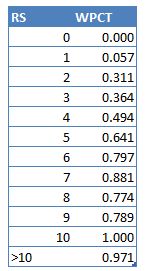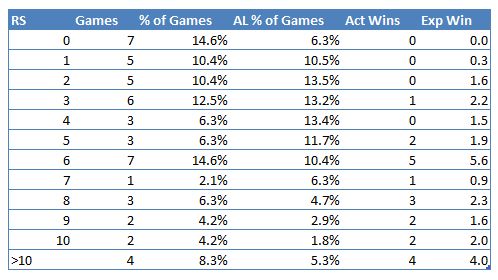9-5. That was the series score. Tigers pitchers kept a very good offensive team to just 9 runs and yet were swept because Detroit went 1-26 with runners in scoring position. The numbers are pretty much mind boggling. And 3 of the Tigers 5 runs came on solo homers. The White Sox took 2 out of 3 games in their weekend series meaning that the Tigers lead is down to a slim 1.5 games. It was a crappy weekend for Detroit baseball. They got swept, they didn’t score, and they lost a relief pitcher for who knows how long. But I’ll find some good news in here somewhere.
Pitching is still good
The Tigers continue to get good pitching. Justin Verlander and Edwin Jackson came out strong and pitched the way they had for the bulk of the first half of the season. Sustained success for both is key to the Tigers playoff chances and with Verlander’s history of second half struggles, and Jackson’s history of never having been this good before, those are both question marks where the early returns are promising.
Also, outside of Joel Zumaya’s blow-up, the bullpen was just as good as the starters. Fu-Te Ni is probably benefiting somewhat from being the new funky-delivery lefty, but his results have been as impressive with the big club as they were with Toledo. I guess the other good news is that the bullpen is nice and rested.
Unsustainable pace
Fortunately for the offense, they won’t continue to be that bad. Going 1 for 26 in any situational split, or any situation period, isn’t a sustainable pace. They’ll at the very least accidentally get a hit at some point in time. But here is the other side of the coin. The Tigers did a good job early in each of the 3 games of making the opposing starter work hard. They were taking pitches, drawing walks, and putting pressure on the starter and thus creating all those scoring opportunities in the first place. That’s the good news. The bad news is that the lineup got destroyed later in the game and the outs came quicker and easier. The Tigers hitters need to carry the types of approaches they were taking early in the game and sustain them throughout and continue to generate the scoring chances.
The Tigers need more offense, and I’d love to see them add a bat, but it goes way beyond that. Even if they trade for a stud, left handed hitting corner outfielder (which is unlikely), he is only going to hit once each time through the lineup. The Tigers have legitimate offensive threats already in the lineup that aren’t producing. One bat isn’t going to have a big impact as long as Granderson/Polanco/Cabrera continue to struggle.
What is Josh Anderson doing in the starting lineup?
One thing the Tigers could do to improve the offense is to remove Josh Anderson from the equation. Anderson had seemingly played himself out of a starting role before the All Star break with Ryan Raburn getting the bulk of the playing time in left field. From June 29th through the break Raburn had 9 starts, Anderson 5 (and one of those was in centerfield to spell Granderson). Raburn hit 323/364/581 over that span and Anderson hit 200/238/350 with no stolen bases. Yet the team gets to New York and Anderson starts 2 of the 3 games.
Raburn is OPS’ing over 800 against both lefties and righties and he has a pretty even mix of plate appearances this year. Anderson is OPS’ing under 650 against both lefties and righties while drawing 88% of his plate appearances against his favorable platoon side. While he is fast, he isn’t a good baserunner. The glaring mistakes are well known, but there are smaller ones as well. On Sunday he slid into second on a fly ball to centerfield. He was stealing and never saw the ball. Plus he had 2 defensive miscues this weekend. One cost the team runs, the other only cost Jackson 6 pitches. Outside of a late inning pinch runner he should have no role on this team, yet he continues to get starts.
Other Stuff
- The extent of Joel Zumaya’s injury still isn’t fully known but it is a re-aggravation of his stress fracture. I’m sure the 3 inning outing in Minnesota didn’t help the situation, but I wouldn’t blame it either. That shoulder has experienced a ton of trauma. I think there are only so many times Zumaya can throw the ball 100mph before the next injury occurs.
- The Tigers were 1 of 7 teams to have scouts on hand for Halladay’s outing yesterday. The White Sox weren’t. I don’t think the Tigers have the pieces, or at least pieces they’d be willing to part with, to get Halladay so I’d chalk up yesterday’s appearance to either due dilligence or gamesmanship.
- What is the smarter financial move for Mike Ilitch, who is faced with decreased revenue due to lower ticket sales and decreased corporate sponsorship, dumping payroll or adding players to keep the Tigers in the hunt? Extended contention and a possible playoff birth will do more to help the franchise’s economic outlook than trying to save on salary. The Tigers need to get through 2010 and then there is considerable salary relief coming.
- Brandon Lyon has added a cut fastball and he has tweaked his delivery.
- Curtis Granderson is holding a wine-tasting charity event this Thursday that features a bachelor auction. For more information on purchasing tickets, or if you’d like to learn how you can take home your very own Granderson or Jackson head over the Grand Kids Foundation site.
- FS Detroit has started to replay each Tiger game at midnight with the Tigers live postgame show to air at 3 a.m. So if you miss either the first time, you have a second chance to DVR it.
- Also coming up on FS Detroit is Batting Stance Guy. He’ll be recreating Magglio Ordonez’s ALCS homer and Justin Verlander’s no hitter. For more on Gar Ryness, check out his appearance on Letterman. He’s already got a compilation of Tigers past and present.



